Part II: State-of-the-Art Technologies of Solar-Powered DC Microgrid with Hybrid Energy Storage Systems: Converter Topologies
Abstract
:1. Introduction
2. Converter Topologies for Solar-Powered HESS
2.1. Topology Classifications of BDCs
2.1.1. Non-Isolated Topologies
Conventional Topologies
- (a)
- Non-Isolated Buck and Boost-derived BDC [2]
- (b)
- Non-Isolated Buck–Boost-derived BDC [3]
- (c)
- (d)
Bridge Topologies
- (e)
- (f)
- Switched-Capacitor BDC [11]
Soft-Switching Topologies
- (g)
Multi-Phase Topologies
- (h)
- (i)
Multilevel Topologies
- (j)
- FC–Multilevel non-isolated BDC [21]
- (k)
- Multilevel cascaded DC-DC converter topology [22]
- (l)
2.1.2. Isolated Topologies
Conventional Topologies
- (a)
- Isolated Buck–Boost BDC (Bidirectional Flyback) [29]
- (b)
- (c)
- (d)
Bridge Topologies
- (e)
- Single-Active Bridge (SAB) converter [41]
- (f)
- (g)
- (h)
- (i)
Soft-Switching Topologies
- (j)
- Full-bridge series resonant converter [40]
- High operating switching frequency due to inherent low switching losses;
- Use of unavoidable parasitic capacitances included in the resonant tank;
- Low EMI levels;
- More power density;
- One capacitor is sufficient for the output filter;
- Inherent short-circuit protection because of resonant inductance connected in series with the load;
- Flat efficiency versus load.
- (l)
- SPCD converter topology [62]
- (m)
- Boost–full-bridge converter for bidirectional high-power application [63]
- (n)
- Boost half-bridge and full-bridge [65]
- Dual-input connectivity;
- Minimum number of switches and their corresponding gate driver elements;
- ZVS turn-on of the primary switches;
- ZCS turn-off of the diodes by eliminating the reverse recovery problem.
- (o)
- Two-stage isolated BDC [67]
- (p)
Multi-Phase Topologies
- (q)
- High-voltage DC-DC full-bridge converter [66]
- (r)
Multilevel Topologies
- (s)
- (t)
- Three-Phase Three-Level DC-DC converter [76]
3. Discussion
- A.
- Discussion on Non-isolated/Isolated power topologies
- B.
- Unidirectional/Bidirectional feature
- C.
- Voltage-Fed/Current-Fed topologies
- D.
- Hard-Switched/Soft-Switched topologies
- E.
- Components count, size, and weight
- F.
- Wide-Voltage range of operation
- G.
- Losses and Cooling requirement
4. Future Directions and Recent Trends
- A.
- Reducing Component Count
- B.
- Increasing Input Operational Voltage Range
- C.
- Soft-Switched Converters
- D.
- Modular Structure
- E.
- Control Aspects
5. Conclusions
- Non-isolated converters in DC microgrids are favored for their simple architectures, cheap weight and manufacturing costs, and adaptability for low- to medium-power levels.
- Isolated converters in DC microgrid layouts offer reduced noise and EMI concerns, high conversion gains, compliance with most utility grid regulations, and ease of implementation of numerous output topologies with positive and/or negative voltage rails.
- When there is only one direction of power flow, unidirectional converters are preferable. In such situations, these converters can provide benefits such as simple modulation and control, reduced complexity, and low cost.
- On the other hand, bidirectional converters can be used anytime forward and reverse power flow is required (suitability for regenerative applications). However, it necessitates the use of sophisticated FET drivers and control units.
- Input current ripples (sometimes discontinuous) and intrinsic buck characteristics plague voltage-fed converters. Fast dynamic reaction is provided by these converters. Due to qualities like continuous input current with tiny ripple and intrinsic boost characteristics, current-fed topologies can be a viable alternative to voltage-fed converters. However, due to the input inductor and RHP zero, these converters have a delayed dynamic response.
- Large switching losses, strong EMI due to high dv/dt and di/dt at switching transitions, limited switching frequency, low power density, and low efficiency are all common problems with hard-switched converters.
- Due to zero-switching losses (ZVS and ZCS), high switching frequency, better power density, and high efficiency, soft-switched converters can be a viable alternative to hard-switched converters. However, these converters required some intricate analysis.
- Non-minimum-phase systems offer a slow dynamic response, small stability margins, and often challenging control designing.
- Minimum-phase converters offer fast dynamic response, large stability margins, and easy control designing.
- There are five different HESS configurations, such as passive, SC semi-active, battery semi-active, full-active, and three-level, that are available for DC microgrid applications.
- Passive HESS configuration is a simple design and requires less cost, size, and volume. However, it has the disadvantages of low volumetric efficiency and low flexibility in HESS design, and incomplete utilization of SC capacity.
- Full-active topology is the best among all configurations. It has a good control effect, and independent control over each ES device is possible. But, it has some disadvantages, such as high initial cost, robustness, and size due to the extra controllers needed for BDCs.
- Semi-active configuration has the mixed advantages of the passive and active configurations. Primary passive with active secondary ES is the optimal solution for RE applications. This semi-active configuration offers advantages such as wide voltage ranges of operation, improving the volumetric efficiency, and less expensive than full-active topology. However, the limitations are vast, and instability in the DC bus voltage and the low volumetric efficiency of SC usage are expected in battery semi-active HESS.
Author Contributions
Funding
Data Availability Statement
Conflicts of Interest
References
- Raveendhra, D.; Poojitha, R.; Narasimharaju, B.L.; Dreglea, A.; Liu, F.; Panasetsky, D.; Pathak, M.; Sidorov, D. Part-I: State-of-the-Art Technologies of Solar Powered DC Microgrid with Hybrid Energy Storage Systems-Architecture Topologies. Energies 2023, 16, 923. [Google Scholar] [CrossRef]
- Matsuo, H.; Kurokawa, F. New Solar Cell Power Supply System Using a Boost Type Bidirectinal DC-DC Converter. IEEE Trans. Ind. Electron. 1984, IE-31, 51–55. [Google Scholar] [CrossRef]
- Caricchi, F.; Crescimbini, F.; Noia, G.; Pirolo, D. Experimental study of a bidirectional DC-DC converter for the DC link voltage control and the regenerative braking in PM motor drives devoted to electrical vehicles. In Proceedings of the 1994 IEEE Applied Power Electronics Conference and Exposition—ASPEC’94, Orlando, FL, USA, 13–17 February 1994; pp. 381–386. [Google Scholar] [CrossRef]
- Middlebrook, R.; Cuk, S.; Behen, W. A new battery charger/discharger converter. In Proceedings of the 1978 IEEE Power Electronics Specialists Conference, Syracuse, NY, USA, 13–15 June 1978; pp. 251–255. [Google Scholar] [CrossRef]
- Cuk, S. A new zero-ripple switching DC-to-DC converter and integrated magnetics. IEEE Trans. Magn. 1983, 19, 57–75. [Google Scholar] [CrossRef]
- Majo, J.; Martinez, L.; Poveda, A.; de Vicuna, L.; Guinjoan, F.; Sanchez, A.; Valentin, M.; Marpinard, J. Large-signal feedback control of a bidirectional coupled-inductor Cuk converter. IEEE Trans. Ind. Electron. 1992, 39, 429–436. [Google Scholar] [CrossRef]
- Kim, I.-D.; Paeng, S.-H.; Ahn, J.-W.; Nho, E.-C.; Ko, J.-S. New Bidirectional ZVS PWM Sepic/Zeta DC-DC Converter. In Proceedings of the 2007 IEEE International Symposium on Industrial Electronics, Vigo, Spain, 4–7 June 2007; pp. 555–560. [Google Scholar] [CrossRef]
- Song, M.-S.; Son, Y.-D.; Lee, K.-H. Non-isolated Bidirectional Soft-switching SEPIC/ZETA Converter with Reduced Ripple Currents. J. Power Electron. 2014, 14, 649–660. [Google Scholar] [CrossRef]
- Caricchi, F.; Crescimbini, F.; Capponi, F.G.; Solero, L. Study of bi-directional buck-boost converter topologies for application in electrical vehicle motor drives. In Proceedings of the APEC ‘98 Thirteenth Annual Applied Power Electronics Conference and Exposition, Anaheim, CA, USA, 15–19 February 1998; pp. 287–293. [Google Scholar]
- Lee, H.-S.; Yun, J.-J. High-Efficiency Bidirectional Buck–Boost Converter for Photovoltaic and Energy Storage Systems in a Smart Grid. IEEE Trans. Power Electron. 2019, 34, 4316–4328. [Google Scholar] [CrossRef]
- Chung, H.S.-H.; Ioinovici, A.; Cheung, W.-L. Generalized structure of Bi-directional switched-capacitor DC/DC converters. IEEE Trans. Circuits Syst. I Fundam. Theory Appl. 2003, 50, 743–753. [Google Scholar] [CrossRef]
- Chung, H.S.; Chow, W.C.; Hui, S.Y.R.; Lee, S.T. Development of a switched-capacitor DC-DC converter with bi-directional power flow. IEEE Trans. Circuits Syst. I Fundam. Theory Appl. 2000, 47, 1383–1389. [Google Scholar]
- Rahimi, S.; Rezvanyvardom, M.; Mirzaei, A. A Fully Soft-Switched Bidirectional DC–DC Converter with Only One Auxiliary Switch. IEEE Trans. Ind. Electron. 2019, 66, 5939–5947. [Google Scholar]
- Rathore, A.K.; Patil, D.R.; Srinivasan, D. Non-isolated Bidirectional Soft-Switching Current-Fed LCL Resonant DC/DC Converter to Interface Energy Storage in DC Microgrid. IEEE Trans. Ind. Appl. 2016, 52, 1711–1722. [Google Scholar]
- Zhang, J.; Lai, J.-S.; Yu, W. Bidirectional DC-DC converter modeling and unified controller with digital implementation. In Proceedings of the 2008 Twenty-Third Annual IEEE Applied Power Electronics Conference and Exposition, Austin, TX, USA, 24–28 February 2008; pp. 1747–1753. [Google Scholar] [CrossRef]
- Garcia, O.; Zumel, P.; de Castro, A.; Cobos, A. Automotive DC-DC bidirectional converter made with many interleaved buck stages. IEEE Trans. Power Electron. 2006, 21, 578–586. [Google Scholar] [CrossRef]
- Huang, X.; Lee, F.C.; Li, Q.; Du, W. High-frequency high-efficiency GaN-based interleaved CRM bidirectional buck/boost converter with inverse coupled inductor. IEEE Trans. Power Electron. 2016, 31, 4343–4352. [Google Scholar]
- Wang, Y.-F.; Xue, L.-K.; Wang, C.-S.; Wang, P.; Li, W. Interleaved high-conversion-ratio bidirectional DC-DC converter for distributed energy-storage Systems-Circuit generation, analysis, and design. IEEE Trans. Power Electron. 2016, 31, 5547–5561. [Google Scholar] [CrossRef]
- Su, B.; Wang, Y.; Wang, X.; Wang, F.; Ming, J.; Guo, Z. Multi-Phase Interleaved Bidirectional DC/DC Converter with Two-Winding Coupled Inductors. In Proceedings of the 2019 IEEE 3rd International Electrical and Energy Conference (CIEEC), Beijing, China, 7–9 September 2019; pp. 433–438. [Google Scholar] [CrossRef]
- Mayer, R.; El Kattel, M.B.; Possamai, M.D.; Bruning, C.; Oliveira, S.V.G. Analysis of a multi-phase interleaved bidirectional DC/DC power converter with coupled inductor. In Proceedings of the 2017 Brazilian Power Electronics Conference (COBEP), Juiz de Fora, Brazil, 19–22 November 2017; pp. 1–6. [Google Scholar] [CrossRef]
- Peng, F.; Zhang, F.; Qian, Z. A magnetic-less DC-DC converter for dual voltage automotive systems. In Proceedings of the Conference Record of the 2002 IEEE Industry Applications Conference. 37th IAS Annual Meeting (Cat. No.02CH37344), Pittsburgh, PA, USA, 13–18 October 2002; pp. 1303–1310. [Google Scholar] [CrossRef]
- Hafez, A.A. Multi-level cascaded DC/DC converters for PV applications. Alex. Eng. J. 2015, 54, 1135–1146. [Google Scholar] [CrossRef]
- Morales-Saldana, J.; Gutierrez, E.E.C.; Leyva-Ramos, J. Modeling of switch-mode dc-dc cascade converters. IEEE Trans. Aerosp. Electron. Syst. 2002, 38, 295–299. [Google Scholar] [CrossRef]
- Cai, W.; Fahimi, B.; Cosoroaba, E.; Yi, F. Stability analysis and voltage control method based on virtual resistor and proportional voltage feedback loop for cascaded DC-DC converters. In Proceedings of the 2014 IEEE Energy Conversion Congress and Exposition (ECCE), Pittsburgh, PA, USA, 14–18 September 2014; pp. 3016–3022. [Google Scholar] [CrossRef]
- Kashani, M.G.; Mobarrez, M.; Bhattacharya, S. Variable interleaving technique for photovoltaic cascaded DC-DC converters. In Proceedings of the IECON 2014—40th Annual Conference of the IEEE Industrial Electronics Society, Dallas, TX, USA, 29 October 2014–1 November 2014; pp. 5612–5617. [Google Scholar]
- Fan, Z.; Peng, F.Z.; Zhaoming, Q. Study of the multilevel converters in DC-DC applications. In Proceedings of the 2004 IEEE 35th Annual Power Electronics Specialists Conference (IEEE Cat. No.04CH37551), Aachen, Germany, 20–25 June 2004; pp. 1702–1706. [Google Scholar]
- Gowaid, I.A.; Adam, G.P.; Massoud, A.M.; Ahmed, S.; Holliday, D.; Williams, B.W. Quasi Two-Level Operation of Modular Multilevel Converter for Use in a High-Power DC Transformer with DC Fault Isolation Capability. IEEE Trans. Power Electron. 2014, 30, 108–123. [Google Scholar] [CrossRef]
- Khan, F.H.; Tolbert, L.M. A Multilevel Modular Capacitor-Clamped DC–DC Converter. IEEE Trans. Ind. Appl. 2007, 43, 1628–1638. [Google Scholar] [CrossRef]
- Gorji, S.A.; Ektesabi, M.; Zheng, J. Isolated switched-boost push-pull DC-DC converter for step-up applications. IEET Electron. Lett. 2017, 53, 177–179. [Google Scholar] [CrossRef]
- Kazimierczuk, M.K.; Vuong, D.Q.; Nguyen, B.T.; Weimer, J.A. Topologies of bidirectional PWM DC-DC power converters. In Proceedings of the IEEE 1993 National Aerospace and Electronics Conference-NAECON 1993, Dayton, OH, USA, 24–28 May 1993; pp. 435–441. [Google Scholar]
- Gorji, S.A.; Mostaan, A.; My, H.T.; Ektesabi, M. Non-isolated buck-boost DC-DC converter with quadratic voltage gain ratio. IET Power Electron. 2019, 12, 1425–1433. [Google Scholar] [CrossRef]
- Delshad, M.; Farzanehfard, H. A new isolated bidirectional buck-boost PWM converter. In Proceedings of the 2010 1st Power Electronic & Drive Systems & Technologies Conference (PEDSTC), Tehran, Iran, 17–18 February 2010; pp. 41–45. [Google Scholar] [CrossRef]
- Kwon, M.; Park, J.; Choi, S. A Bidirectional Three-Phase Push–Pull Converter with Dual Asymmetrical PWM Method. IEEE Trans. Power Electron. 2015, 31, 1887–1895. [Google Scholar] [CrossRef]
- Lin, B.-R.; Chen, J.-J.; Lee, Y.-E.; Chiang, H.-K. Analysis and implementation of a bidirectional ZVS dc-dc converter with active clamp. In Proceedings of the 2008 3rd IEEE Conference on Industrial Electronics and Applications, Singapore, 3–5 June 2008; pp. 382–387. [Google Scholar] [CrossRef]
- Khodabakhshian, M.; Adib, E.; Farzanehfard, H. Forward-type resonant bidirectional DC-DC converter. IEET Power Electron. 2016, 9, 1753–1760. [Google Scholar] [CrossRef]
- Zhang, F.; Yan, Y. Novel forward-flyback hybrid bidirectional DC-DC converter. IEEE Trans. Ind. Electron. 2009, 56, 1578–1584. [Google Scholar] [CrossRef]
- Zhang, Z.; Thomsen, O.C.; Andersen, M.A.E. Optimal Design of a Push-Pull-Forward Half-Bridge (PPFHB) Bidirectional DC–DC Converter With Variable Input Voltage. IEEE Trans. Ind. Electron. 2011, 59, 2761–2771. [Google Scholar] [CrossRef]
- De Souza, E.V.; Barbi, I. Bidirectional current-fed flyback-pushpull DC-DC converter. In Proceedings of the XI Brazilian Power Electronics Conference, Natal, Brazil, 11–15 September 2011; pp. 8–13. [Google Scholar]
- Aboulnaga, A.A.; Emadi, A. Performance evaluation of the isolated bidirectional Cuk converter with integrated magnetics. In Proceedings of the 2004 IEEE 35th Annual Power Electronics Specialists Conference (IEEE Cat. No.04CH37551), Aachen, Germany, 20–25 June 2004; pp. 1557–1562. [Google Scholar]
- Zhao, C.; Round, S.D.; Kolar, J.W. An Isolated Three-Port Bidirectional DC-DC Converter with Decoupled Power Flow Management. IEEE Trans. Power Electron. 2008, 23, 2443–2453. [Google Scholar] [CrossRef]
- Ruseler, A.; Barbi, I. Isolated Zeta-SEPIC bidirectional dc-dc converter with active-clamping. In Proceedings of the 2013 Brazilian Power Electronics Conference, Gramado, Brazil, 27–31 October 2013; pp. 123–128. [Google Scholar] [CrossRef]
- Max, L.; Thiringer, T. Control method and snubber selection for a 5 MW wind turbine single active bridge DC/DC converter. In Proceedings of the 2007 European Conference on Power Electronics and Applications, Aalborg, Denmark, 2–5 September 2007; pp. 1–10. [Google Scholar] [CrossRef]
- De Doncker, R.; Divan, D.; Kheraluwala, M. A three-phase soft-switched high-power-density DC/DC converter for high-power applications. IEEE Trans. Ind. Appl. 1991, 27, 63–73. [Google Scholar] [CrossRef]
- Kheraluwala, M.; Gasgoigne, R.; Divan, D.; Bauman, E. Performance characterization of a high power dual active bridge DC/DC converter. IEEE Trans. Ind. Appl. 1992, 28, 1294–1301. [Google Scholar] [CrossRef]
- Krismer, F.; Kolar, J.W. Accurate Power Loss Model Derivation of a High-Current Dual Active Bridge Converter for an Automotive Application. IEEE Trans. Ind. Electron. 2010, 57, 881–891. [Google Scholar] [CrossRef]
- Zhao, B.; Song, Q.; Liu, W.; Sun, Y. Overview of Dual-Active-Bridge Isolated Bidirectional DC–DC Converter for High-Frequency-Link Power-Conversion System. IEEE Trans. Power Electron. 2014, 29, 4091–4106. [Google Scholar] [CrossRef]
- Li, X.; Bhat, A.K.S. Analysis and Design of High-Frequency Isolated Dual-Bridge Series Resonant DC/DC Converter. IEEE Trans. Power Electron. 2010, 25, 850–862. [Google Scholar] [CrossRef]
- Chen, W.; Rong, P.; Lu, Z. Snubberless Bidirectional DC–DC Converter with New CLLC Resonant Tank Featuring Minimized Switching Loss. IEEE Trans. Ind. Electron. 2010, 57, 3075–3086. [Google Scholar] [CrossRef]
- Jung, J.H.; Kim, H.S.; Ryu, M.H.; Baek, J.W. Design Methodology of Bidirectional CLLC Resonant Converter for High-Frequency Isolation of DC Distribution Systems. IEEE Trans. Power Electron. 2013, 28, 1741–1755. [Google Scholar] [CrossRef]
- Xu, X.; Khambadkone, A.M.; Oruganti, R. A Soft-Switched Back-to-Back Bi-directional DC/DC Converter with a FPGA based Digital Control for Automotive applications. In Proceedings of the IECON 2007—33rd Annual Conference of the IEEE Industrial Electronics Society, Taipei, Taiwan, 5–8 November 2007; pp. 262–267. [Google Scholar] [CrossRef]
- He, P.; Khaligh, A. Comprehensive Analyses and Comparison of 1 kW Isolated DC–DC Converters for Bidirectional EV Charging Systems. IEEE Trans. Transp. Electrif. 2017, 3, 147–156. [Google Scholar] [CrossRef]
- Peng, F.; Li, H.; Su, G.-J.; Lawler, J. A New ZVS Bidirectional DC–DC Converter for Fuel Cell and Battery Application. IEEE Trans. Power Electron. 2004, 19, 54–65. [Google Scholar] [CrossRef]
- Li, H.; Peng, F.; Lawler, J. A natural ZVS high-power bi-directional DC-DC converter with minimum number of devices. In Proceedings of the Conference Record of the 2001 IEEE Industry Applications Conference. 36th IAS Annual Meeting (Cat. No.01CH37248), Chicago, IL, USA, 30 September 2001–4 October 2001; pp. 1874–1881. [Google Scholar] [CrossRef]
- Park, S.; Song, Y. An interleaved half-bridge bidirectional dc-dc converter for energy storage system applications. In Proceedings of the 8th International Conference on Power Electronics—ECCE Asia, Jeju, Republic of Korea, 30 May 2011–3 June 2011; pp. 2029–2034. [Google Scholar] [CrossRef]
- Morrison, R.; Egan, M. A new power-factor-corrected single-transformer UPS design. IEEE Trans. Ind. Appl. 2000, 36, 171–179. [Google Scholar] [CrossRef]
- Du, Y.; Lukic, S.; Jacobson, B.; Huang, A. Review of high power isolated bi-directional DC-DC converters for PHEV/EV DC charging infrastructure. In Proceedings of the 2011 IEEE Energy Conversion Congress and Exposition, Phoenix, AZ, USA, 17–22 September 2011; pp. 553–560. [Google Scholar]
- Chub, A.; Vinnikov, D.; Kosenko, R.; Liivik, E.; Galkin, I. Bidirectional DC–DC Converter for Modular Residential Battery Energy Storage Systems. IEEE Trans. Ind. Electron. 2020, 67, 1944–1955. [Google Scholar] [CrossRef]
- Tao, H.; Kotsopoulos, A.; Duarte, J.L.; Hendrix, M.A.M. Family of multiport bidirectional DC-DC converters. IEE Proc.-Elect. Power Appl. 2006, 153, 451–458. [Google Scholar]
- Gorji, S.A.; Ektesabi, M.; Zheng, J. Double-input boost/Y-source DC-DC converter for renewable energy sources. In Proceedings of the 2016 IEEE 2nd Annual Southern Power Electronics Conference (SPEC), Auckland, New Zealand, 5–8 December 2016; pp. 1–6. [Google Scholar] [CrossRef]
- Safaee, A.; Karimi-Ghartemani, M.; Jain, P.K.; Bakhshai, A. Time-Domain Analysis of a Phase-Shift-Modulated Series Resonant Converter with an Adaptive Passive Auxiliary Circuit. IEEE Trans. Power Electron. 2016, 31, 7714–7734. [Google Scholar] [CrossRef]
- Mao, S.; Popovic, J.; Ramabhadran, R.; Ferreira, J.A. Comparative study of half-bridge LCC and LLC resonant DC-DC converters for ultra-wide output power range applications. In Proceedings of the 2015 17th European Conference on Power Electronics and Applications (EPE’15 ECCE-Europe), Geneva, Switzerland, 8–10 September 2015; pp. 1–10. [Google Scholar] [CrossRef]
- Li, S.; Fahimi, B. State-space modelling of LLC resonant half-bridge DC–DC converter. IET Power Electron. 2020, 13, 1583–1592. [Google Scholar]
- DeDoncker, R.W.; Kheraluwala, M.H.; Divan, D.M. Power Conversion Apparatus for DC/DC Conversion Using Dual Active Bridges. U.S. Patent 5 027 264, 25 June 1991. [Google Scholar]
- Pahlevani, M.; Eren, S.; Bakhshai, A.; Jain, P. A Series–Parallel Current-Driven Full-Bridge DC/DC Converter. IEEE Trans. Power Electron. 2015, 31, 1275–1293. [Google Scholar] [CrossRef]
- Zhu, L. A novel soft-commutating isolated boost full-bridge ZVS-PWM DC-DC converter for bidirectional high power ap-plications. IEEE Trans. Power Electron. 2006, 21, 422–429. [Google Scholar]
- Zhang, Z.; Thomsen, O.C.; Andersen, M.A.E. Soft-Switched Dual-Input DC–DC Converter Combining a Boost-Half-Bridge Cell and a Voltage-Fed Full-Bridge Cell. IEEE Trans. Power Electron. 2013, 28, 4897–4902. [Google Scholar] [CrossRef]
- Yongxia, H.; Fuchang, L.; Ling, D.; Lei, W.; Luhai, B.; Zhaozhi, L.; Bo, P. Research on applications of TVS and thyristor in a pulsed power supply system used for EMG. IEEE Trans. Dielectr. Electr. Insul. 2009, 16, 979–984. [Google Scholar]
- Soo-Hong, K.; Ehsani, M.; Choon-Sam, K. High-voltage power supply using series connected full-bridge PWM converter for pulsed power applications. IEEE Trans. Dielectr. Electr. Insul. 2015, 22, 1937–1944. [Google Scholar]
- Kwang-Min, Y.; Jun-Young, L. A 10-kW two-stage isolated/bidirectional DC/DC converter with hybrid-switching technique. IEEE Trans. Ind. Electron. 2013, 60, 2205–2213. [Google Scholar]
- Ortiz, G.; Uemura, H.; Bortis, D.; Kolar, J.W.; Apeldoorn, O. Modeling of Soft-Switching Losses of IGBTs in High-Power High-Efficiency Dual-Active-Bridge DC/DC Converters. IEEE Trans. Electron. Devices 2013, 60, 587–597. [Google Scholar] [CrossRef]
- Krismer, F.; Biela, J.; Kolar, J. A comparative evaluation of isolated bi-directional DC/DC converters with wide input and output voltage range. In Proceedings of the Fourtieth IAS Annual Meeting. Conference Record of the 2005 Industry Applications Conference, Hong Kong, China, 2–6 October 2005; Volume 1, pp. 599–606. [Google Scholar]
- Ortiz, G.; Biela, J.; Bortis, D.; Kolar, J.W. 1 Megawatt, 20 kHz, isolated, bidirectional 12 kV to 1.2 kV DC–DC converter for renewable energy applications. In Proceedings of the The 2010 International Power Electronics Conference—ECCE ASIA, Sapporo, Japan, 21–24 June 2010; pp. 3212–3219. [Google Scholar]
- Hua, B.; Mi, C. Eliminate reactive power and increase system efficiency of isolated bidirectional dual-active-bridge DC-DC converters using novel dual-phase-shift control. IEEE Trans. Power Electron. 2008, 23, 2905–2914. [Google Scholar]
- Hanju, C.; Jungwan, C.; Enjeti, P.N. A Three-phase current-fed DC/DC Converter with active clamp for low-DC renewable energy sources. IEEE Trans. Power Electron. 2008, 23, 2784–2793. [Google Scholar]
- Wang, K.; Zhu, L.; Qu, D.; Odendaal, H.; Lai, J.; Lee, F. Design, implementation, and experimental results of bi-directional full-bridge DC/DC converter with unified soft-switching scheme and soft-starting capability. In Proceedings of the 2000 IEEE 31st Annual Power Electronics Specialists Conference. Conference Proceedings (Cat. No.00CH37018), Galway, Ireland, 23 June 2000; pp. 1058–1063. [Google Scholar] [CrossRef]
- Franceschini, G.; Lorenzani, E.; Cavatorta, M.; Bellini, A. 3boost a high power three-phase step-up full-bridge converter for automotive applications. IEEE Trans. Ind. Electron. 2008, 55, 173–183. [Google Scholar] [CrossRef]
- Khan, S.; Zaid, M.; Siddique, M.D.; Iqbal, A. Ultra high gain step up DC/DC converter based on switched inductor and improved voltage lift technique for high-voltage applications. IET Power Electron. 2022, 15, 932–952. [Google Scholar] [CrossRef]
- Yavari, M.; Salemnia, A.; Javadi, H. A new step-up DC-DC converter with high gain for photovoltaic applications. Int. J. Circuit Theory Appl. 2023, 51, 702–727. [Google Scholar]
- Jagtap, N.; Pattnaik, S.; Pandey, A. A High Gain Modified Voltage Lift Cell Based DC-DC Converter Using Single Switch. In Proceedings of the 2022 IEEE 1st Industrial Electronics Society Annual On-Line Conference (ONCON), Kharagpur, India, 9–11 December 2022; pp. 1–6. [Google Scholar]
- Shaw, P.; Siddique, M.D.; Mekhilef, S.; Iqbal, A. A new family of high gain boost DC-DC converters with reduced switch voltage stress for renewable energy sources. Int. J. Circuit Theory Appl. 2023, 51, 1265–1285. [Google Scholar] [CrossRef]
- Samiullah, M.; Siddique, M.D.; Iqbal, A.; Maroti, P.K.; Banerjee, S. A non-isolated symmetrical design of voltage lift switched-inductor boost converter with higher gain and low voltage stress across switches. IET Power Electron. 2022, 1–8. [Google Scholar] [CrossRef]
- Siwakoti, Y.P.; Peng, F.Z.; Blaabjerg, F.; Loh, P.C.; Town, G.E. Impedance-Source Networks for Electric Power Conversion Part I: A Topological Review. IEEE Trans. Power Electron. 2014, 30, 699–716. [Google Scholar] [CrossRef]
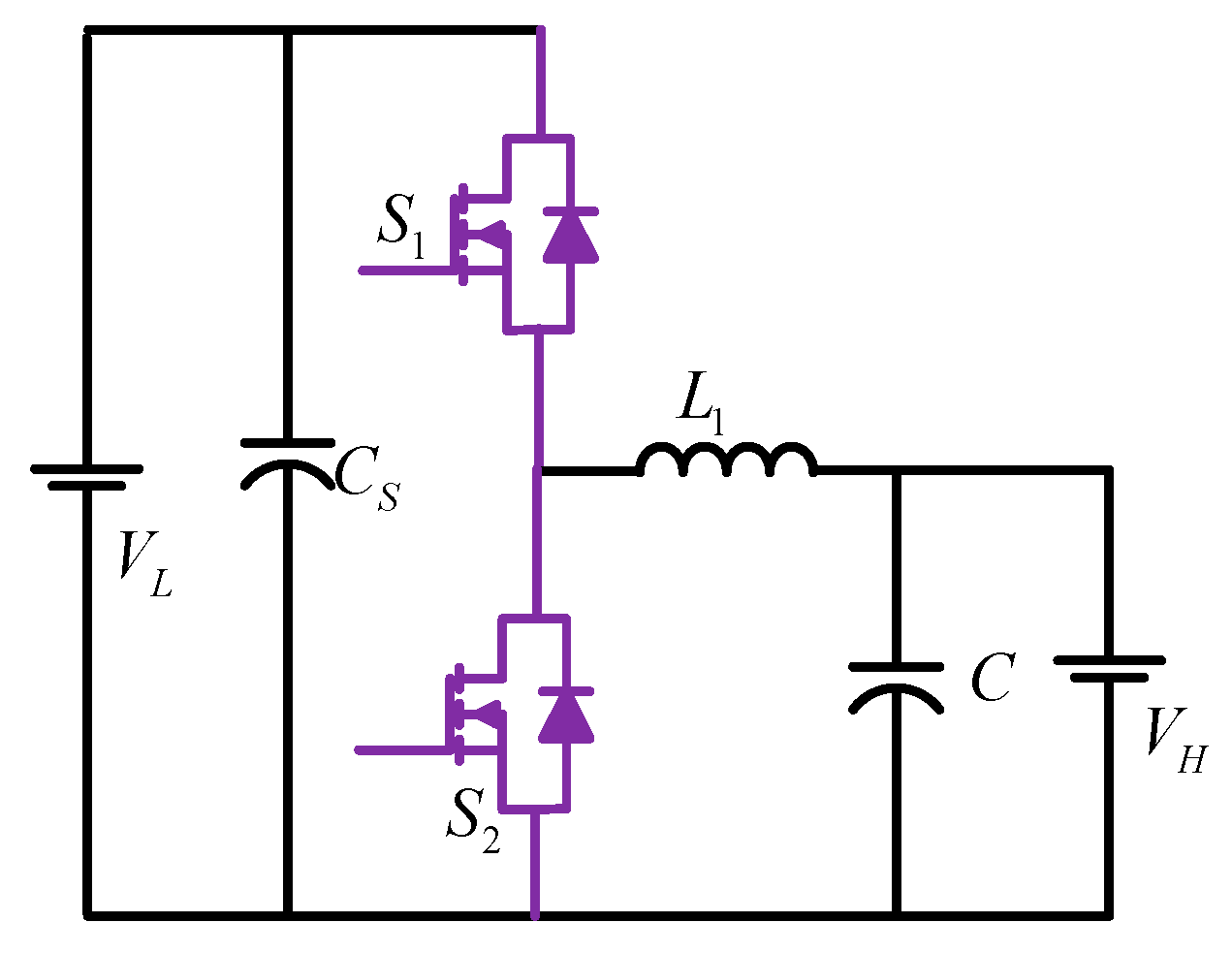
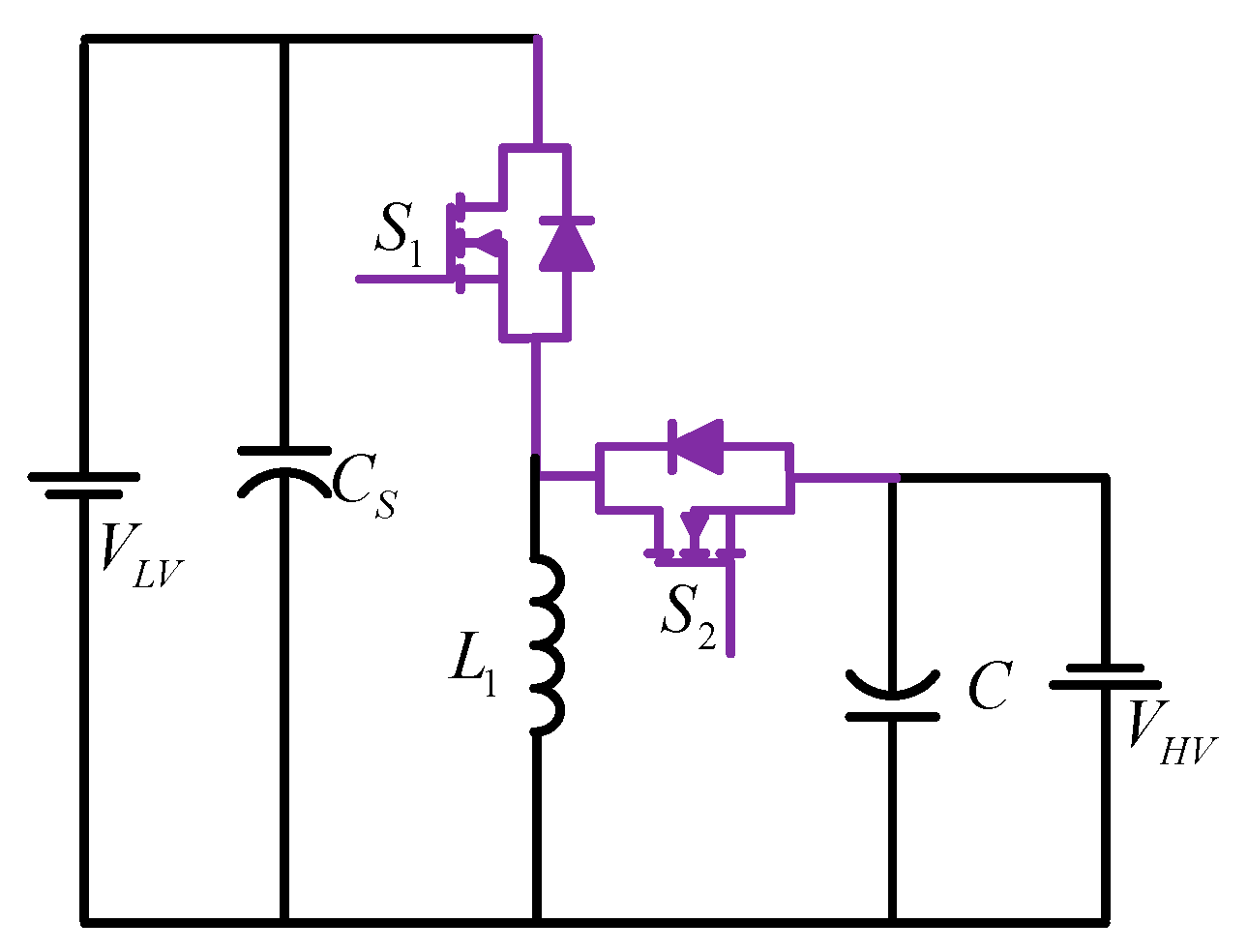
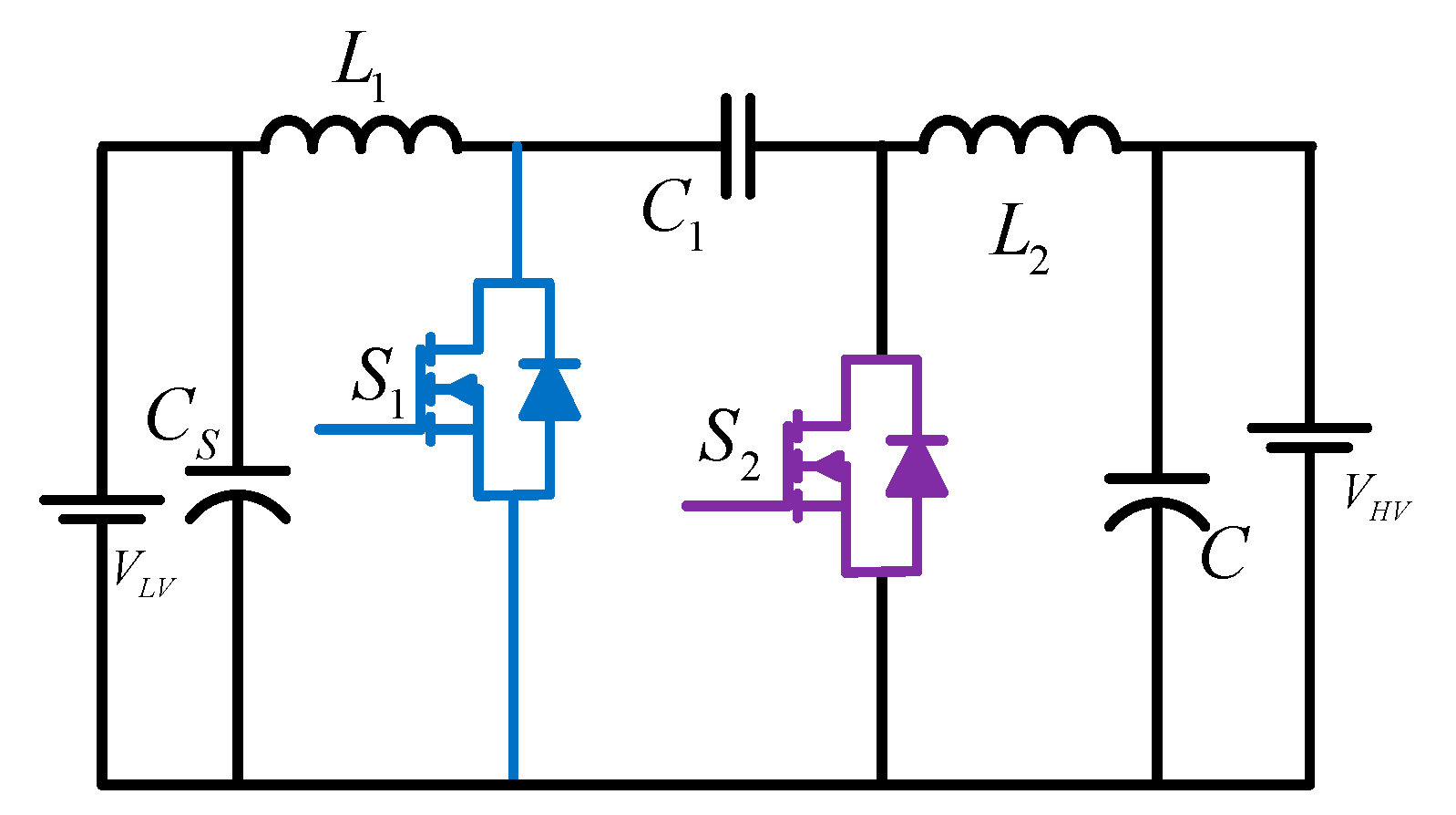
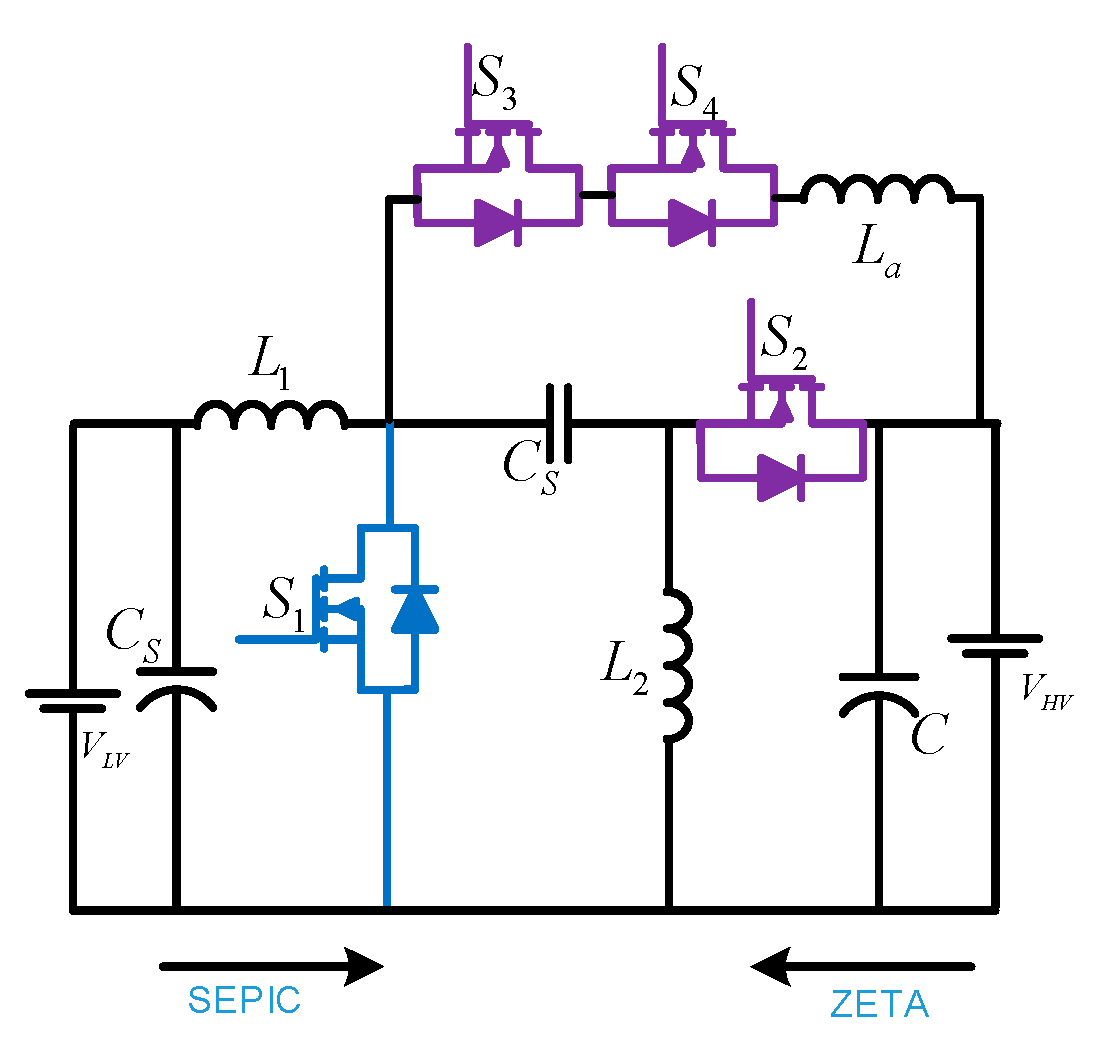




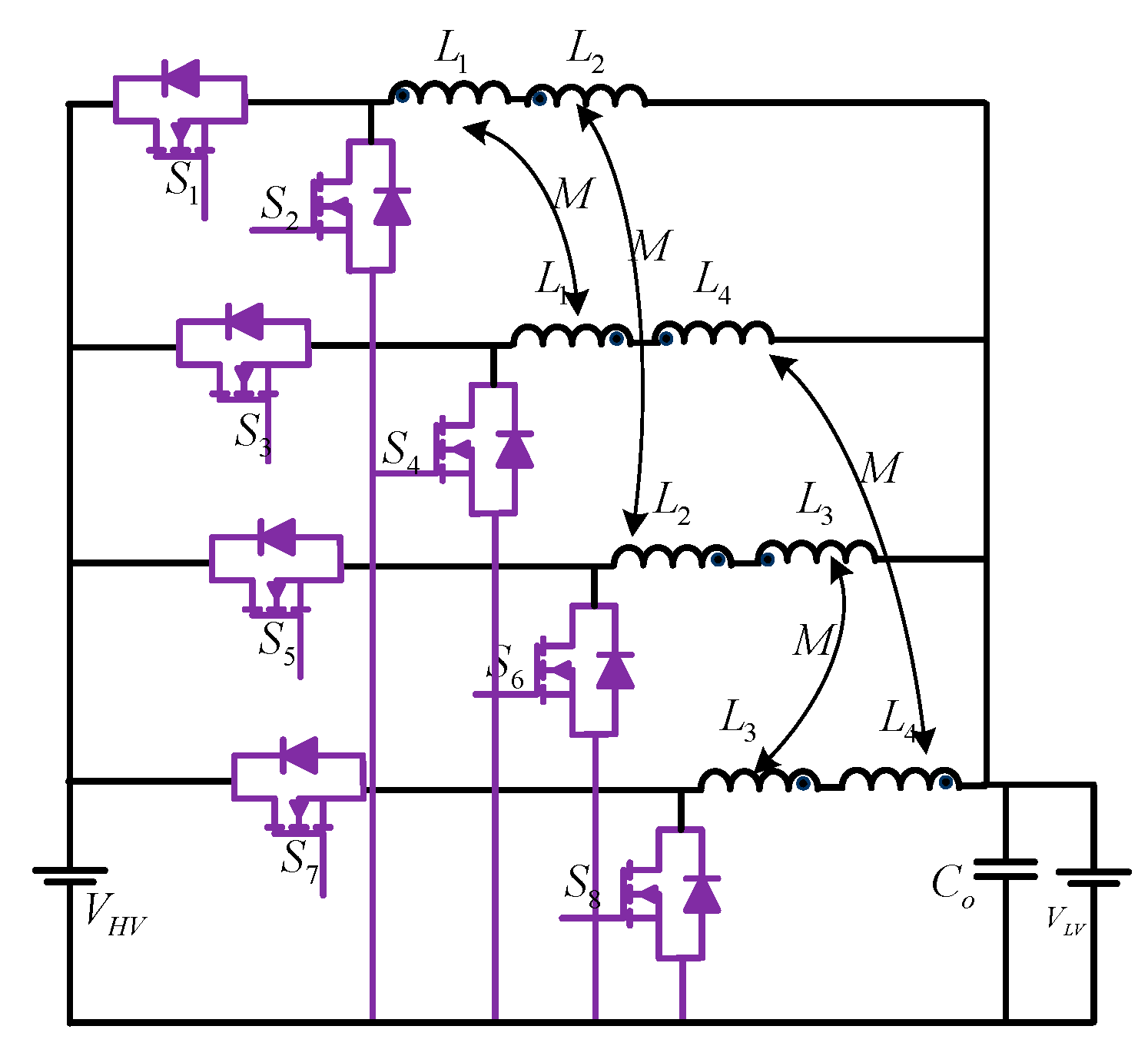
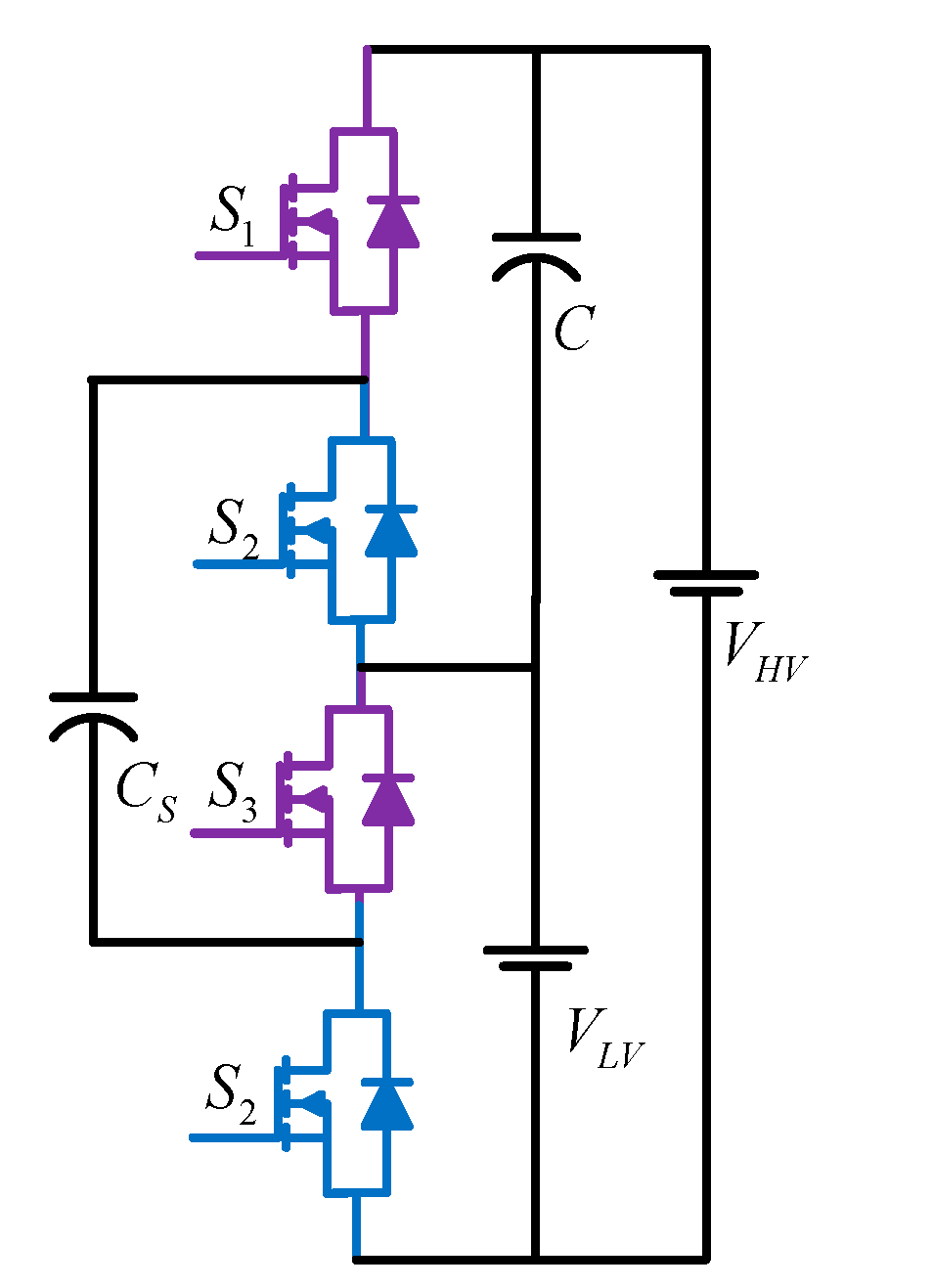

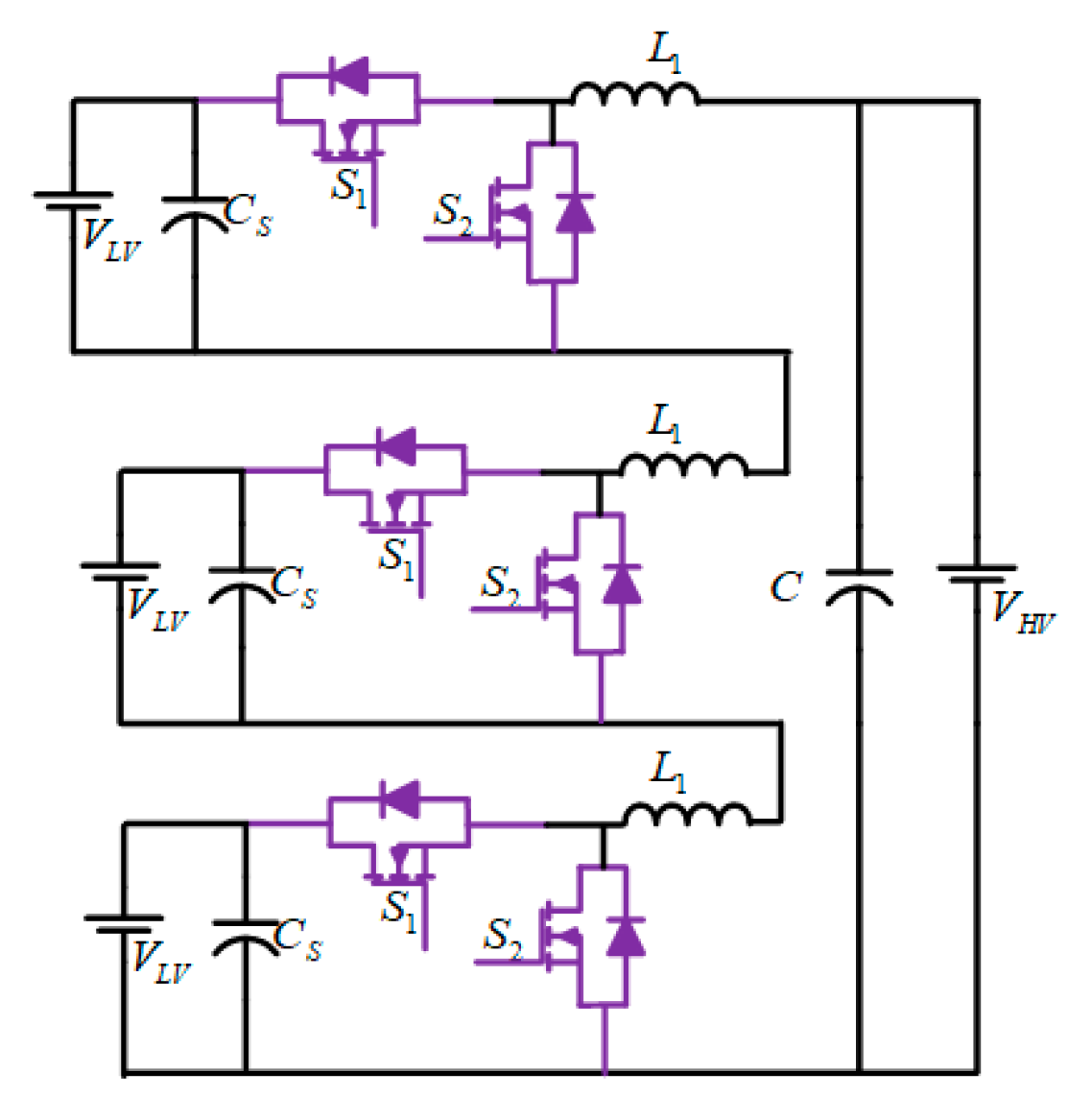

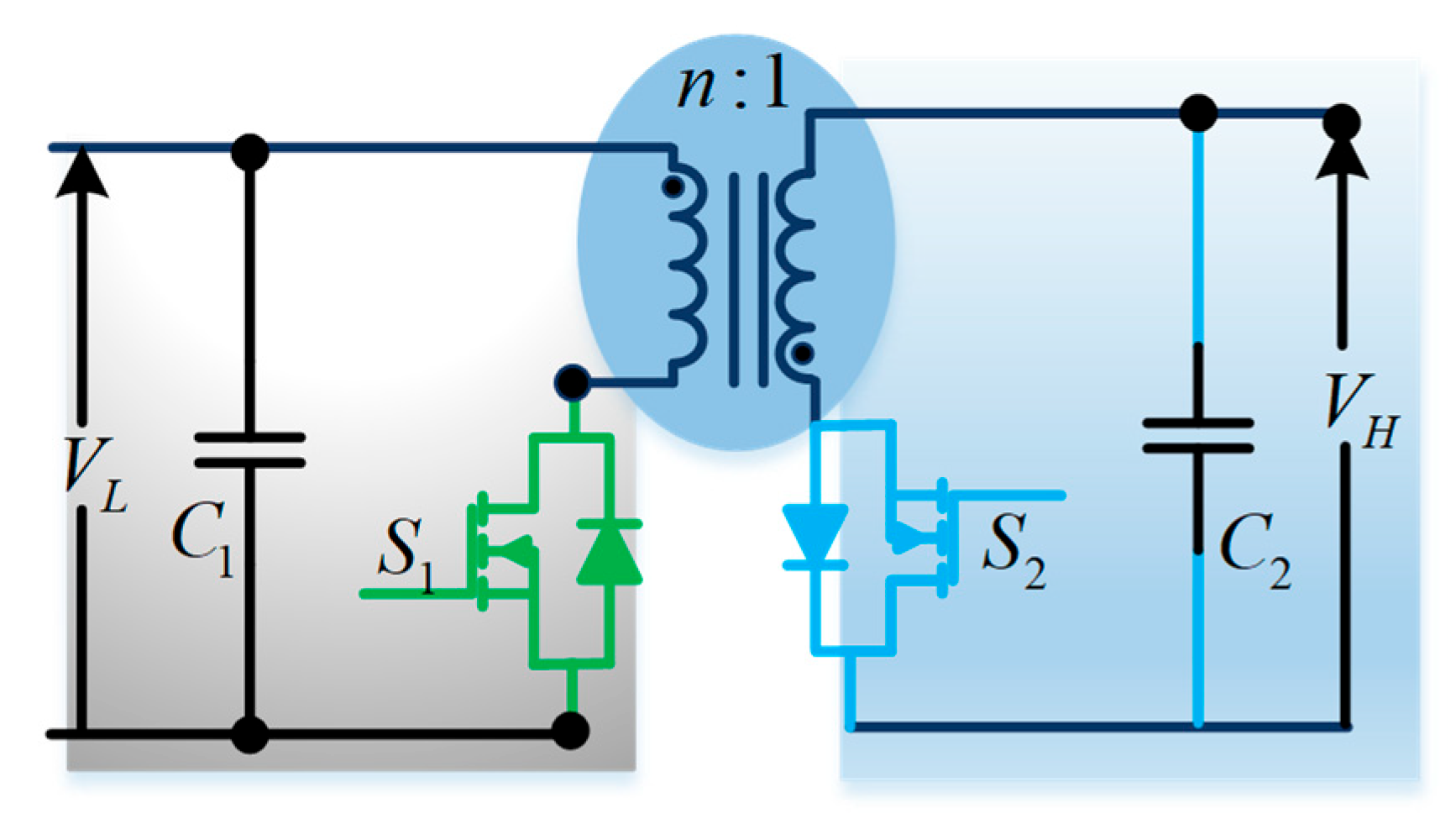
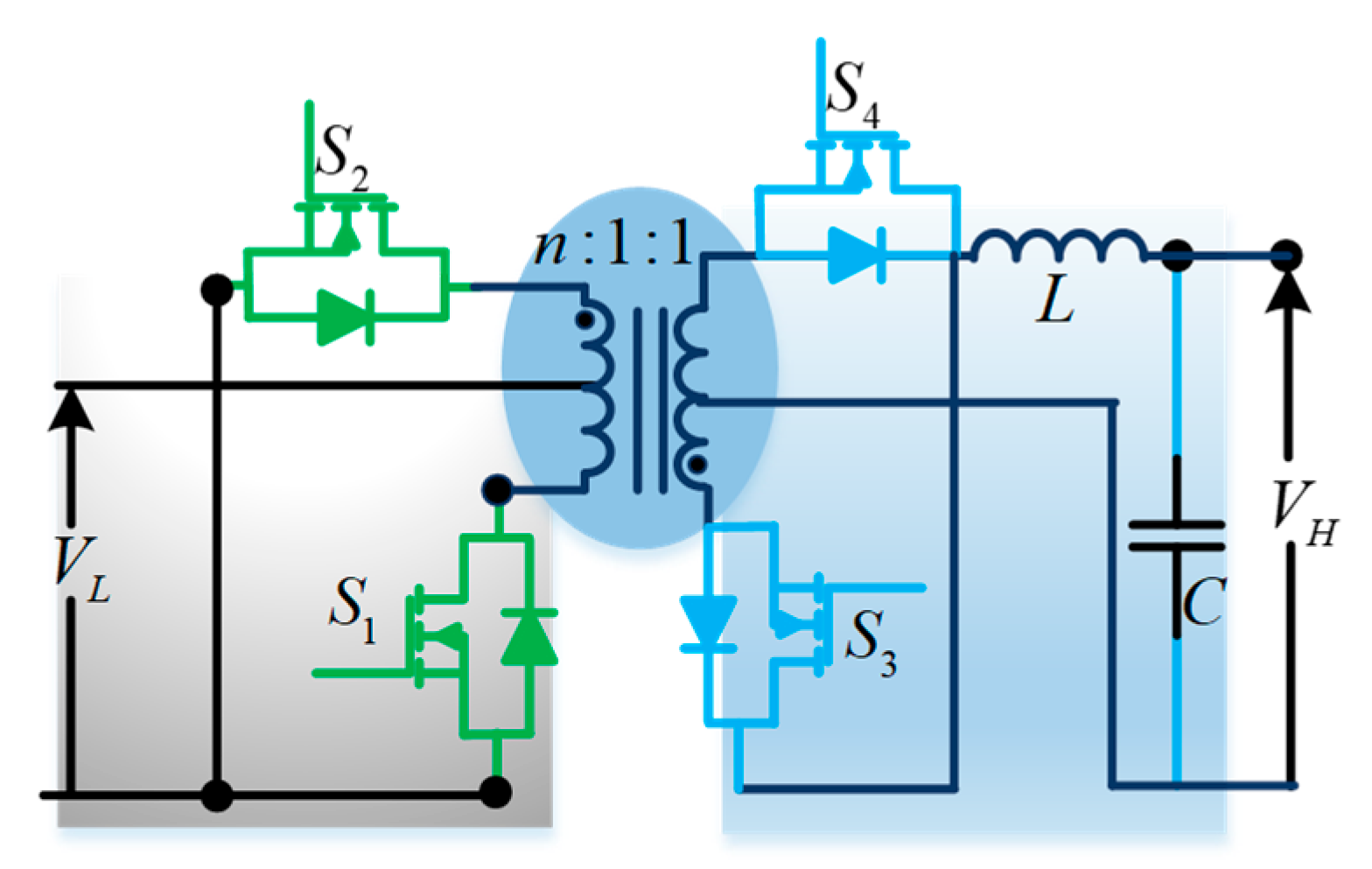





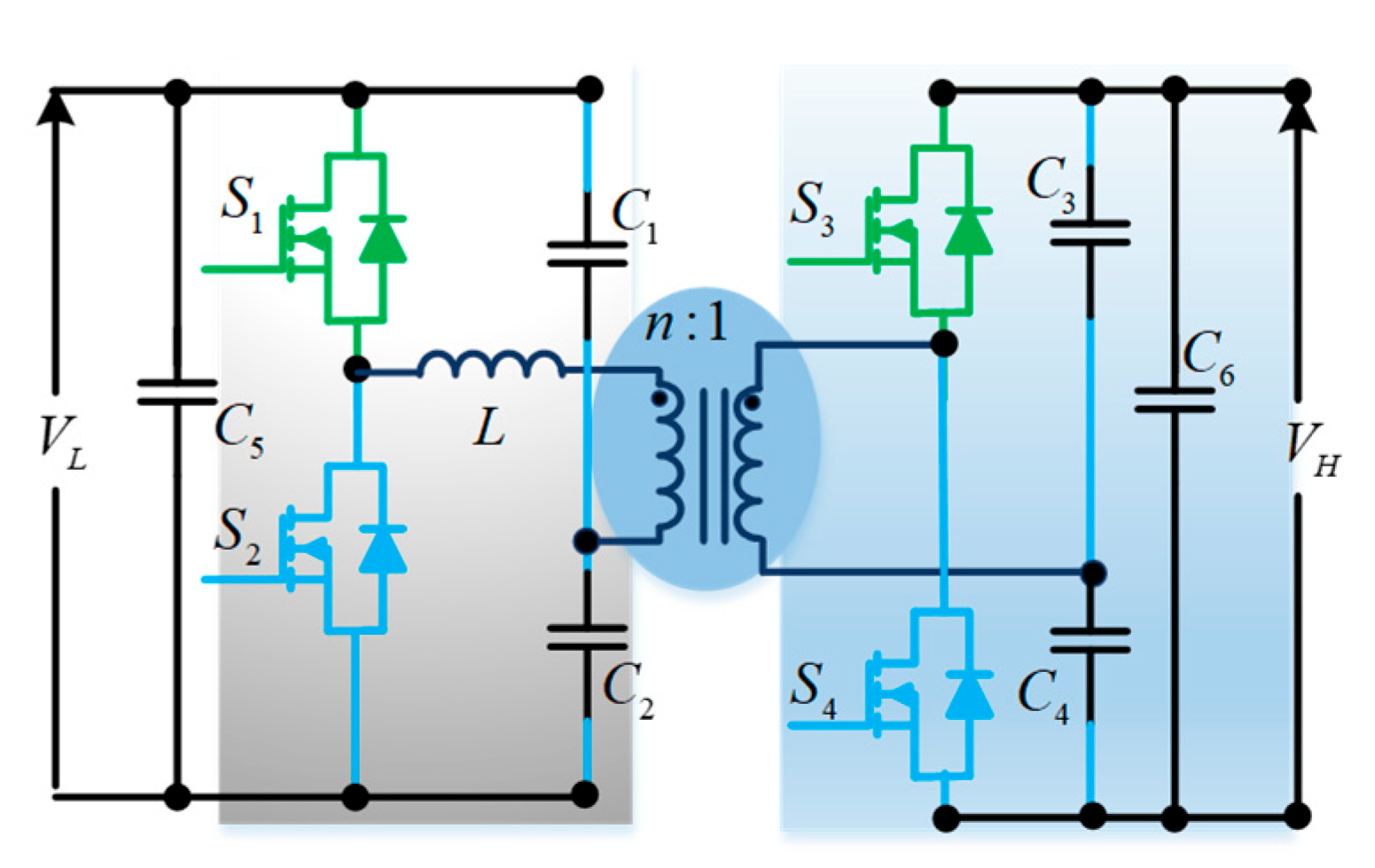


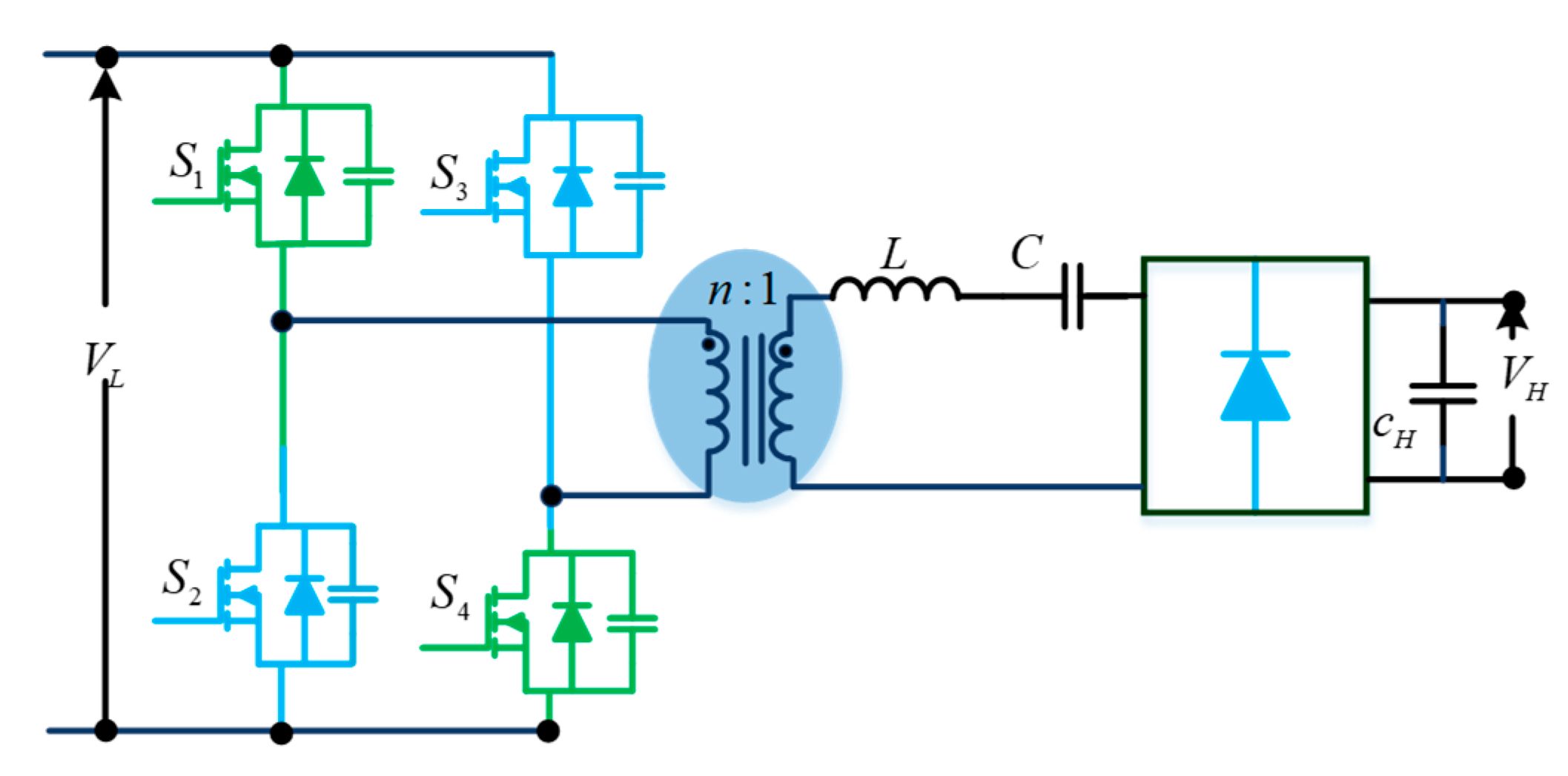
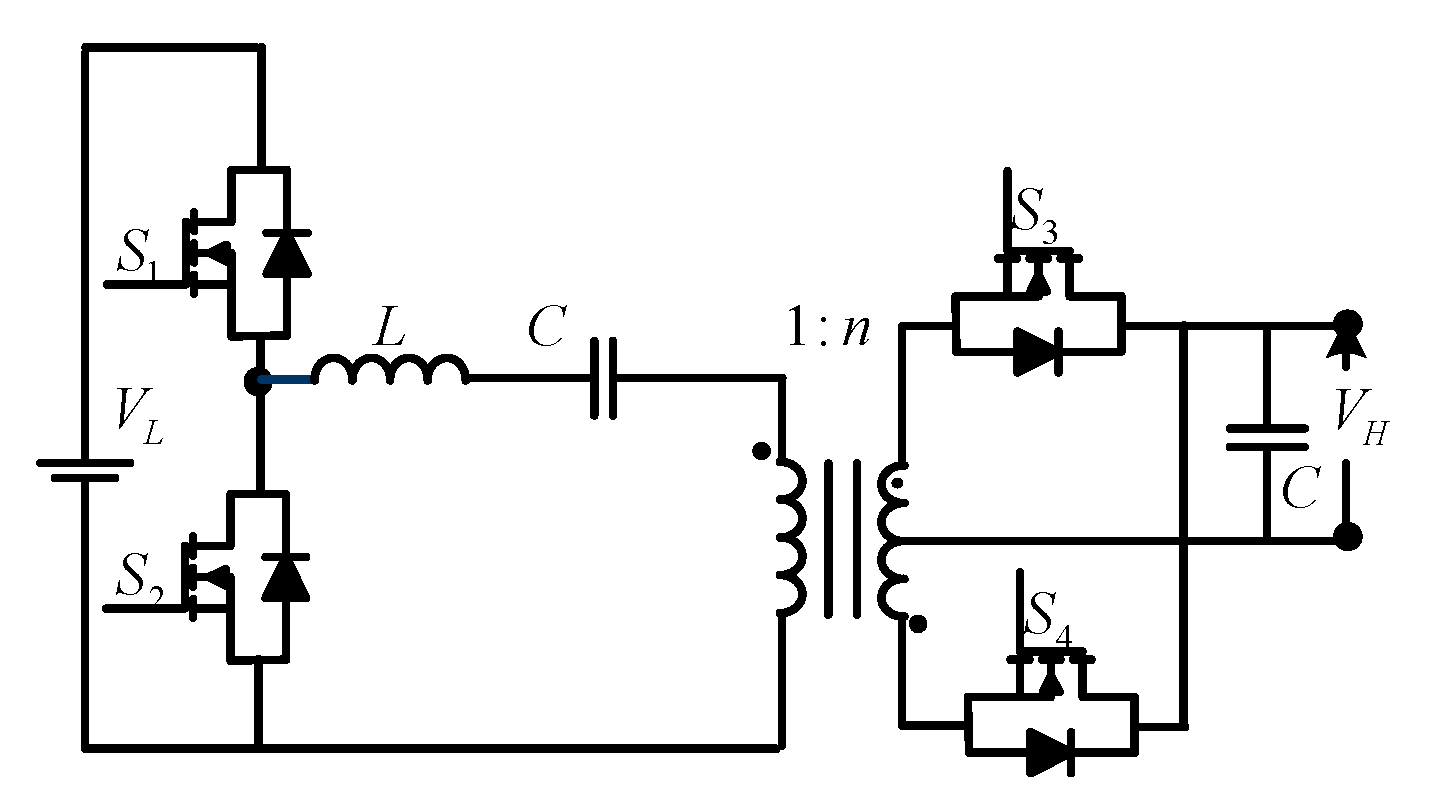
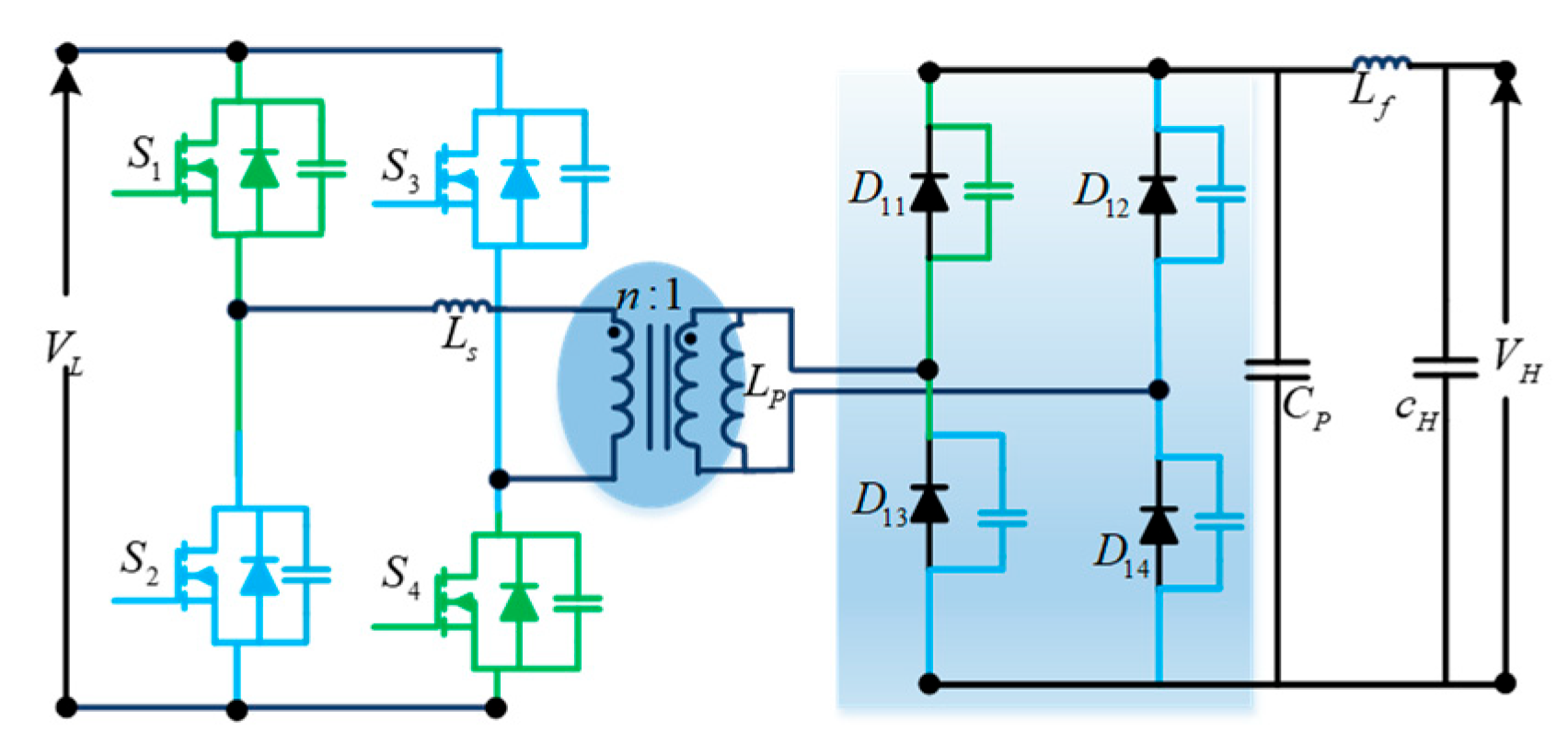



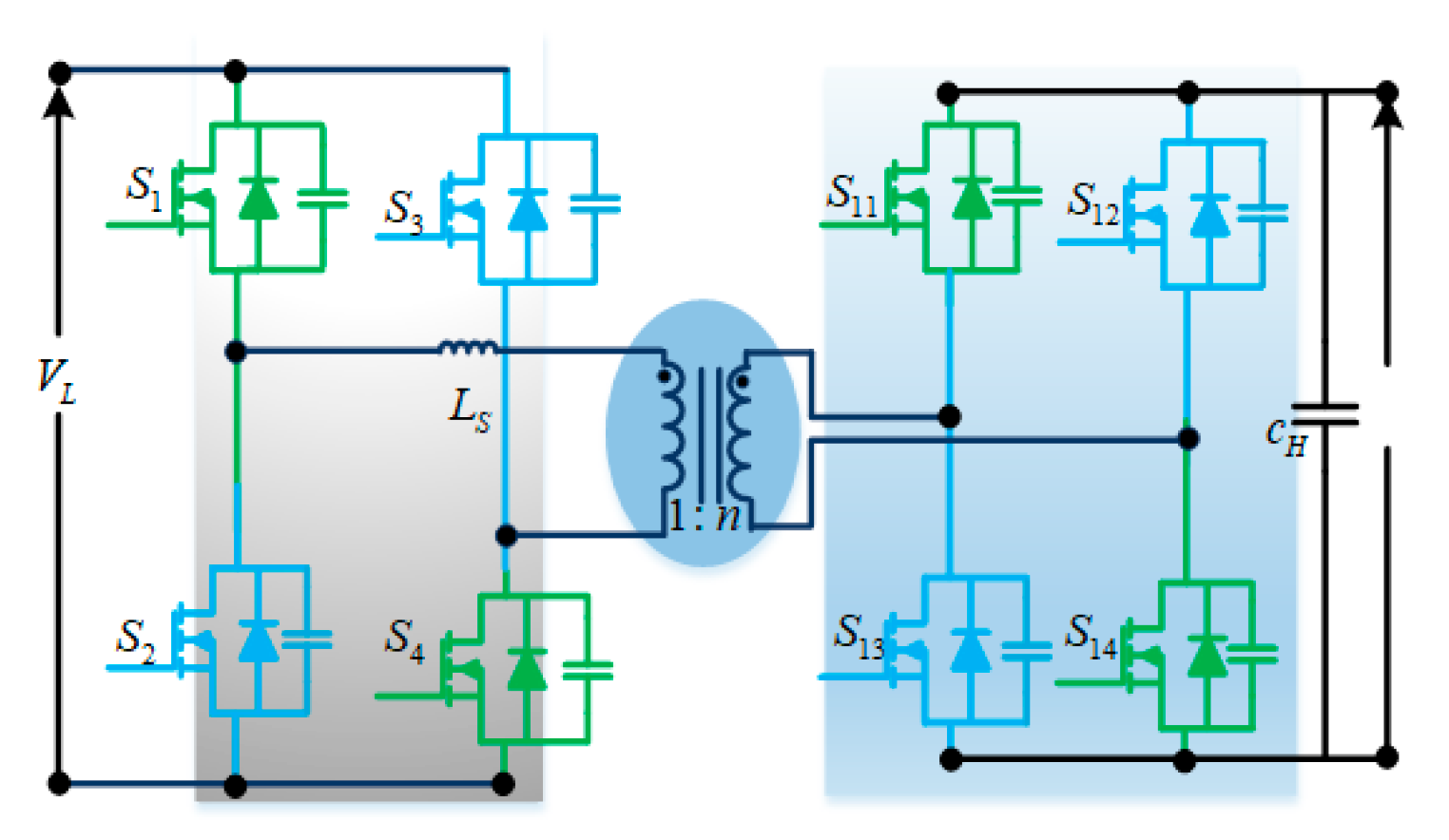


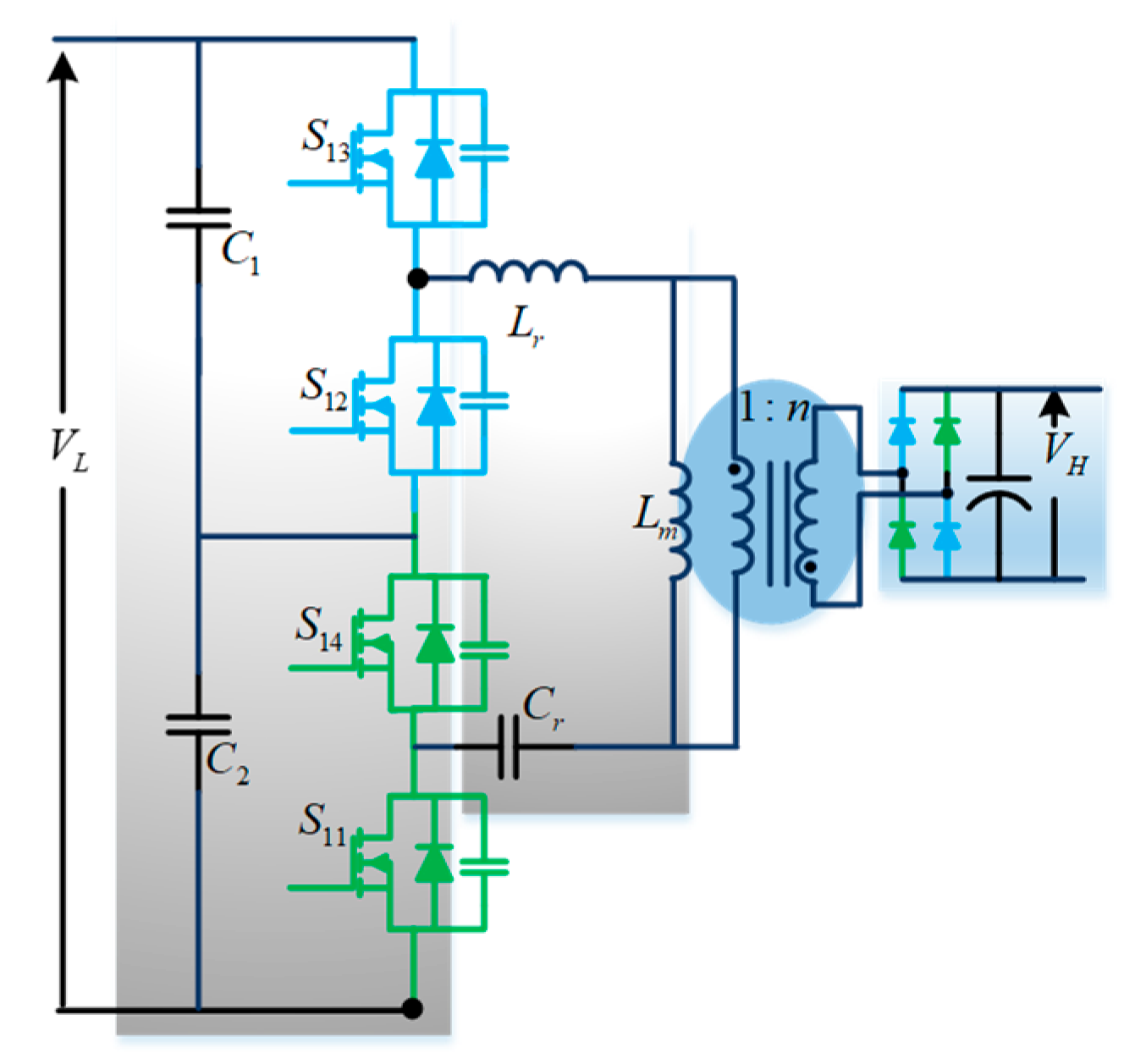
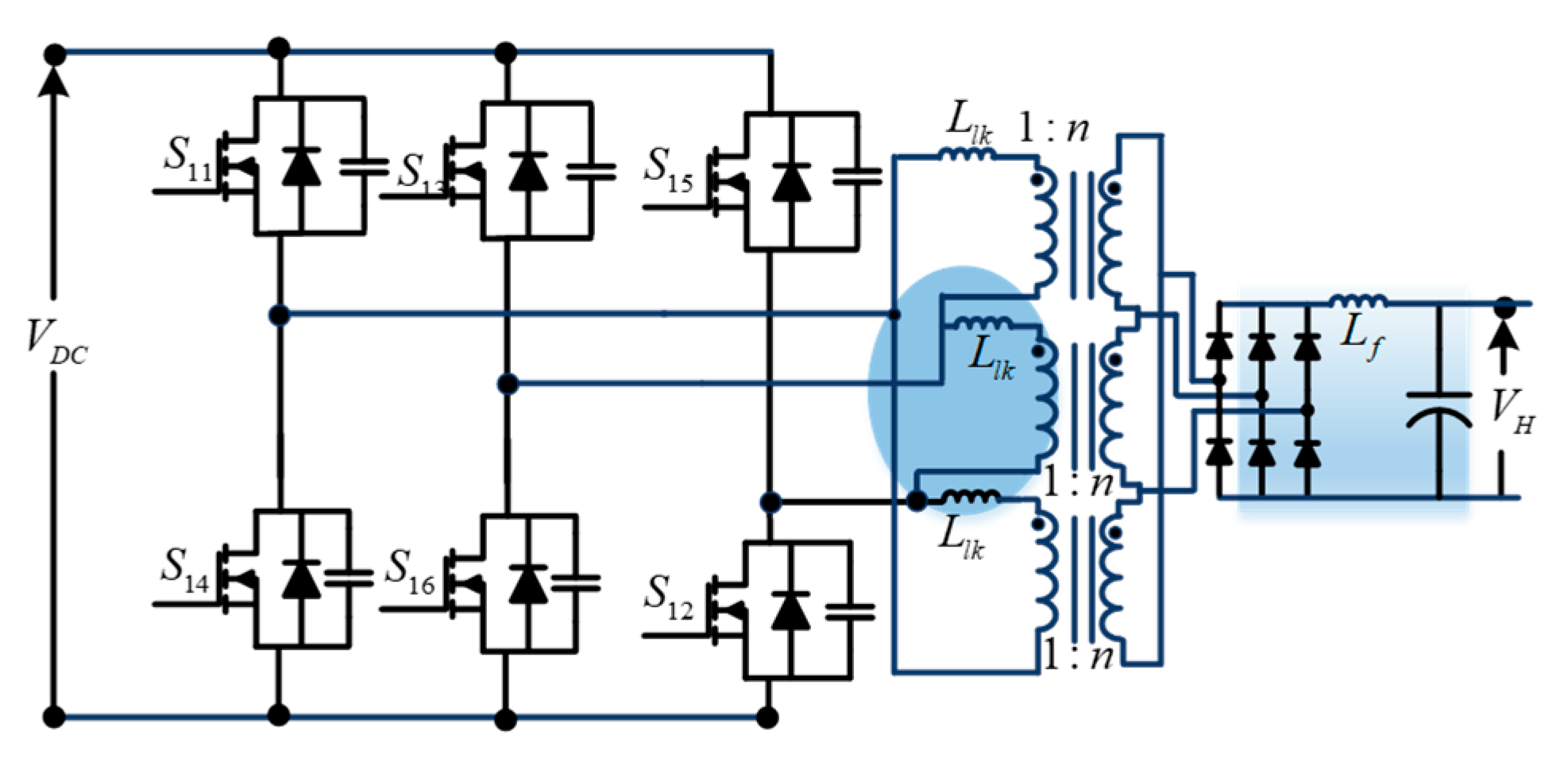
| Topology | Figure | Reference | VH/VL | Inductors | Capacitors | Switches | Characteristics | Other Applications |
|---|---|---|---|---|---|---|---|---|
| Basic Buck and Boost | Figure 1 | [2] | 1 | 2 | 2 |
| The photovoltaic system, UPS | |
| Buck–Boost | Figure 2 | [3] | 2 | 2 | 2 |
| Electric vehicle | |
| Cuk | Figure 3 | [6] | 2 | 3 | 4 |
| Battery storage system | |
| SEPIC/Zeta | Figure 4 | [7,8] | 2 | 3 | 2 |
| Distributed power system | |
| Cascaded | Figure 5 | [9,10] | 1 | 2 | 4 |
| Electric vehicle, Smart grid | |
| Switched Capacitor | Figure 6 | [11] | 2 | 0 | 3 | 4 |
| Distributed Energy Resources |
| Fully soft-switched Buck and Boost BDC | Figure 7 | [13] | 3 | 2 | 3 + 4D (D-Diodes) |
| PV systems, wind, fuel cell, etc. | |
| Interleaved | Figure 8 | [17,18,19] | n = 2 | 2 | 2n=4 |
| High-power applications, DERs | |
| Four-phase IBDC with TCIs | Figure 9 | 4 | 2 | 8 |
| Suitable for medium- and high-power applications | ||
| ML-FC-based non-isolated | Figure 11 | [21] | - | 6 | 12 |
| Automotive applications | |
| Multilevel cascaded | Figure 12 | [22] | n= 1 | n = 1 | n = 2 |
| Photovoltaic applications | |
| 5L-MMCCC | Figure 13 | [28] | - | 5 | 13 |
| Automotive applications like HEV |
| Topology | Figure | Reference | VH/VL | L | C | S | W | Characteristics, Incl. Efficiency Analysis | Applications, Incl. Low- and Medium-Power Applications |
|---|---|---|---|---|---|---|---|---|---|
| Flyback | Figure 14 | [29] | 0 | 2 | 2 | 2 |
| UPS, Low–Medium power applications | |
| Push–Pull | Figure 15 | [32] | 2 | 4 | 2 | 2 |
| Low-power applications, Photovoltaic systems | |
| Forward | Figure 16 | [33,34] | 1 | 1 | 4 | 4 |
| Medium power (2ϕ)– High-power applications (3ϕ) | |
| Cuk & SEPIC/ZETA | Figure 17 | [39] | 1 | 1 | 3 | 3 |
| Low–Medium power applications | |
| SAB converter | Figure 18 | [41] | 1 | 2 | 4 + 4D | 2 |
| Wind farm application | |
| DAB | Figure 19 | [44] | 0 (V-fed) | 2 | 8 | 2 |
| High-power applications, Automotive applications | |
| Dual Half-Bridge | Figure 21 | [49,50] | 0 (V-fed) | 6 | 4 | 2 |
| Automotive, Fuel cell, Battery | |
| Half Full-Bridge | Figure 22 | [56] | 0 (V-fed) | 4 | 6 | 2 |
| UPS, Electric vehicle | |
| Multiport DAB | Figure 23 | [57] | 0 (V-fed) | n = 3 | 4n = 12 | n=3 |
| Multi-Sustainable Sources, Generation system | |
| Full-Bridge series resonant converter | Figure 24 | [40] | 1 | 2 | 4 | 2 |
| ||
| LLC resonant Half-Bridge Converter | Figure 25 | [60] | 3 | 4 | 6 + 2D | 2 |
| Solar PV applications | |
| SPCD converter topology | Figure 26 | [62] | 3 | 3 | 4 + 4D | 2 |
| High-voltage high-frequency applications | |
| Boost–FB converter | Figure 27 | [64] | 2 | 3 | 8 | 2 |
| Bidirectional high-power applications | |
| Boost HB and FB converter | Figure 28 | [63] | 2 | 9 | 6 + 2D | 4 |
| HEV, SC HESS, PV/FC generation systems | |
| Two-stage isolated bidirectional DC-DC converter | Figure 29 | [68] | 2 | 5 | 8 | 2 |
| High-voltage high-power bidirectional applications, Automotive applications | |
| TCM-DAB | Figure 30 | [66] | 1 | 2 | 8 | 2 |
| Medium-voltage and medium-frequency applications | |
| High-voltage DC-DC FB converter | Figure 31 | [65] | 1 | 4 | 4 + 6D | 6 |
| High-voltage high-frequency applications | |
| 3-P current-fed DC-DC converter with active clamp | Figure 32 | [70] | 1 | 2 | 7 + 6D | 6 |
| Low-DC RE sources, like fuel cells, PV, battery applications | |
| 3-L DC-DC converter with LLC resonant tank | Figure 33 | [73] | 2 | 4 | 4 + 4D | 2 |
| High- and medium-voltage/power applications | |
| 3-P 3-L DC-DC converter | Figure 34 | [74] | 1 | 1 | 6 + 6D | 6 |
| High-input-voltage applications |
Disclaimer/Publisher’s Note: The statements, opinions and data contained in all publications are solely those of the individual author(s) and contributor(s) and not of MDPI and/or the editor(s). MDPI and/or the editor(s) disclaim responsibility for any injury to people or property resulting from any ideas, methods, instructions or products referred to in the content. |
© 2023 by the authors. Licensee MDPI, Basel, Switzerland. This article is an open access article distributed under the terms and conditions of the Creative Commons Attribution (CC BY) license (https://creativecommons.org/licenses/by/4.0/).
Share and Cite
Raveendhra, D.; Poojitha, R.; Narasimharaju, B.L.; Domyshev, A.; Dreglea, A.; Dao, M.H.; Pathak, M.; Liu, F.; Sidorov, D. Part II: State-of-the-Art Technologies of Solar-Powered DC Microgrid with Hybrid Energy Storage Systems: Converter Topologies. Energies 2023, 16, 6194. https://doi.org/10.3390/en16176194
Raveendhra D, Poojitha R, Narasimharaju BL, Domyshev A, Dreglea A, Dao MH, Pathak M, Liu F, Sidorov D. Part II: State-of-the-Art Technologies of Solar-Powered DC Microgrid with Hybrid Energy Storage Systems: Converter Topologies. Energies. 2023; 16(17):6194. https://doi.org/10.3390/en16176194
Chicago/Turabian StyleRaveendhra, Dogga, Rajana Poojitha, Beeramangalla Lakshminarasaiah Narasimharaju, Alexander Domyshev, Aliona Dreglea, Minh Hien Dao, Mukesh Pathak, Fang Liu, and Denis Sidorov. 2023. "Part II: State-of-the-Art Technologies of Solar-Powered DC Microgrid with Hybrid Energy Storage Systems: Converter Topologies" Energies 16, no. 17: 6194. https://doi.org/10.3390/en16176194









